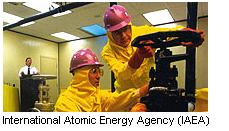NPT Common Questions

1. What is the NPT?
• The NPT is a nuclear arms control and disarmament treaty that is based on three mutually reinforcing pillars:
1. Non-nuclear weapon states parties (NNWS) must not acquire or seek to acquire nuclear weapons or
other nuclear explosive devices, and nuclear weapon states parties (NWS) must not transfer nuclear
weapons or other nuclear explosive devices to NNWS.
2. NWS must pursue negotiations in good faith on effective measures toward the elimination of nuclear
weapons.
3. NWS must assist in the transfer of nuclear technology for peaceful purposes to NNWS.
• NNWS must each conclude a safeguards agreement with the International Atomic Energy Agency (IAEA) in order to verify compliance with the non-diversion of nuclear technology and material meant for peaceful nuclear programs to military programs.
• The NPT was signed on July 1, 1968 by the United States, the United Kingdom, the Soviet Union, and 59 other countries, and entered into force on March 5, 1970.
• In 1992, China and France acceded to the NPT as NWS, and by the end of 1994, the three former Soviet states that possessed nuclear weapons and materials on their territories after the break-up of the Soviet Union each acceded to the NPT as NNWS through the Treaty of Lisbon.
• Israel, India, and Pakistan have never been signatories to the NPT, and North Korea withdrew from the Treaty in 2003.
2. What are IAEA safeguards?
• While the list of specific safeguards implemented by the IAEA is extensive, their main focus is to ensure that civilian nuclear programs of NNWS are peaceful in nature and that NNWS comply with their NPT obligations.
3. What material does the IAEA safeguard?
• All “source and special fissionable material” is under IAEA safeguards.
• This includes any material containing plutonium-239, uranium-233 or uranium-235.
4. Does the NPT expire?
• Article X of the NPT stated that twenty five years after being entered into force, a conference was to decide whether the Treaty shall continue indefinitely.
• On May 11, 1995, the NPT was extended indefinitely.
5. Can states withdraw from the NPT?
• Under Article X of the NPT states parties have the right to withdraw from the Treaty for “extraordinary events” which jeopardize the supreme interest of the country by giving notice to all states parties and the UN Security Council three months in advance.
6. What other considerations exist?
• The Treaty is reviewed every five years in meetings called Review Conferences of the States Parties to the Treaty of Non-Proliferation of Nuclear Weapons.
• The NPT recognizes five NWS (of the 189 signatories to the Treaty); the United States, the Russian Federation, the United Kingdom, China and France.
• Each of these five NWS had detonated a nuclear device prior to 1968, when NPT negotiations began.

